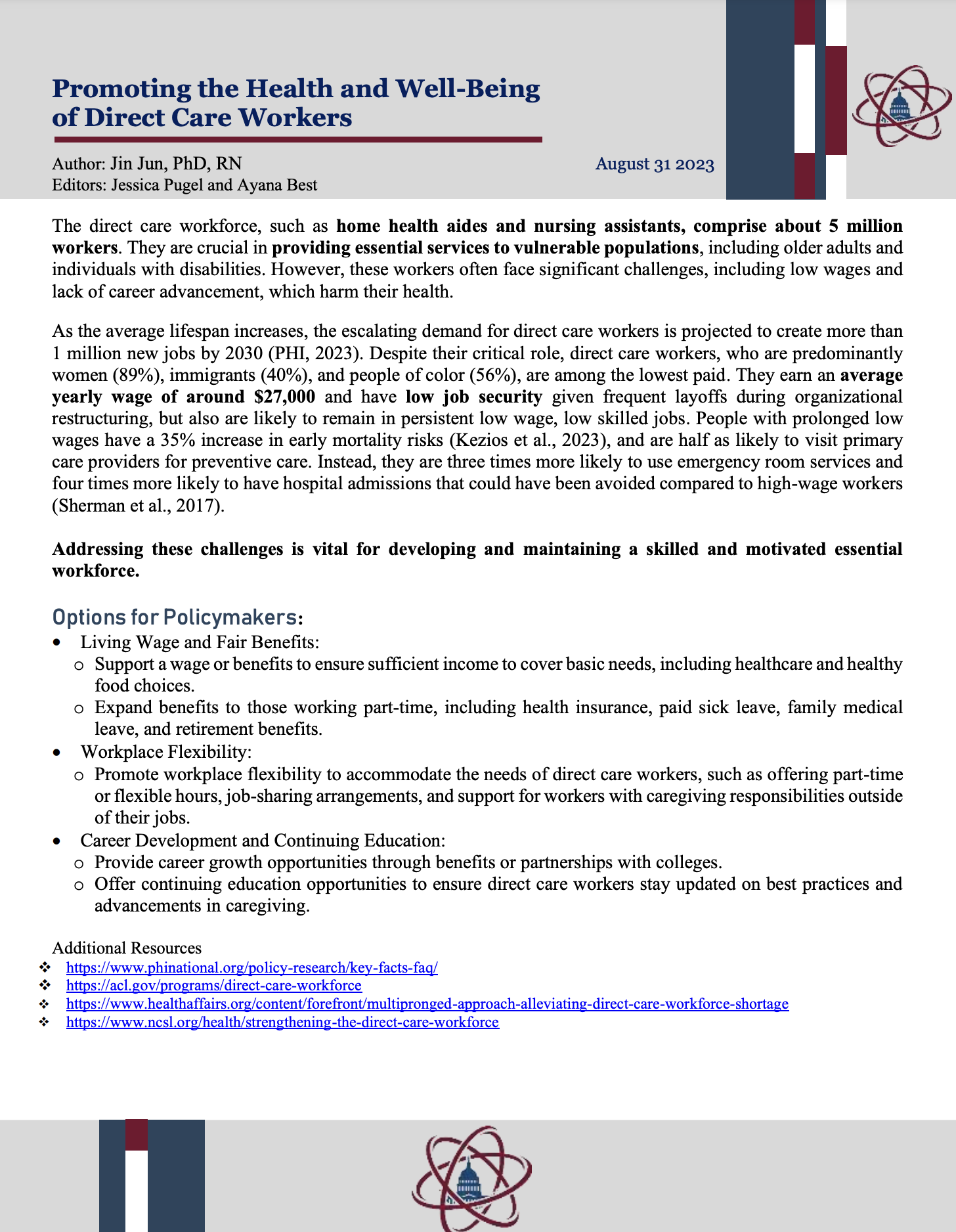
The direct care workforce, such as home health aides and nursing assistants, comprise about 5 million workers. They are crucial in providing essential services to vulnerable populations, including older adults and individuals with disabilities. However, these workers often face significant challenges, including low wages and lack of career advancement, which harm their health.
As the average lifespan increases, the escalating demand for direct care workers is projected to create more than 1 million new jobs by 2030 (PHI, 2023). Despite their critical role, direct care workers, who are predominantly women (89%), immigrants (40%), and people of color (56%), are among the lowest paid. They earn an average yearly wage of around $27,000 and have low job security given frequent layoffs during organizational restructuring, but also are likely to remain in persistent low wage, low skilled jobs. People with prolonged low wages have a 35% increase in early mortality risks (Kezios et al., 2023), and are half as likely to visit primary care providers for preventive care. Instead, they are three times more likely to use emergency room services and four times more likely to have hospital admissions that could have been avoided compared to high-wage workers (Sherman et al., 2017).
Addressing these challenges is vital for developing and maintaining a skilled and motivated essential workforce.
Options For Policy Makers:
- Living Wage and Fair Benefits:
- Support a wage or benefits to ensure sufficient income to cover basic needs, including healthcare and healthy food choices.
- Expand benefits to those working part-time, including health insurance, paid sick leave, family medical leave, and retirement benefits.
- Workplace Flexibility:
- Promote workplace flexibility to accommodate the needs of direct care workers, such as offering part-time or flexible hours, job-sharing arrangements, and support for workers with caregiving responsibilities outside of their jobs.
- Career Development and Continuing Education:
- Provide career growth opportunities through benefits or partnerships with colleges.
- Offer continuing education opportunities to ensure direct care workers stay updated on best practices and advancements in caregiving.
Additional Resources
The Research-to-Policy Collaboration (RPC) works to bring together research professionals and public officials to support evidence-based policy. Please visit their website to learn more.
Key Information
RPC Website
Research-to-Policy Collaboration
Publication DateAugust 31, 2023
Topic Area(s)Health
Resource TypeWritten Briefs
Share This Page
The direct care workforce, such as home health aides and nursing assistants, comprise about 5 million workers. They are crucial in providing essential services to vulnerable populations, including older adults and individuals with disabilities. However, these workers often face significant challenges, including low wages and lack of career advancement, which harm their health.
As the average lifespan increases, the escalating demand for direct care workers is projected to create more than 1 million new jobs by 2030 (PHI, 2023). Despite their critical role, direct care workers, who are predominantly women (89%), immigrants (40%), and people of color (56%), are among the lowest paid. They earn an average yearly wage of around $27,000 and have low job security given frequent layoffs during organizational restructuring, but also are likely to remain in persistent low wage, low skilled jobs. People with prolonged low wages have a 35% increase in early mortality risks (Kezios et al., 2023), and are half as likely to visit primary care providers for preventive care. Instead, they are three times more likely to use emergency room services and four times more likely to have hospital admissions that could have been avoided compared to high-wage workers (Sherman et al., 2017).
Addressing these challenges is vital for developing and maintaining a skilled and motivated essential workforce.
Options For Policy Makers:
- Living Wage and Fair Benefits:
- Support a wage or benefits to ensure sufficient income to cover basic needs, including healthcare and healthy food choices.
- Expand benefits to those working part-time, including health insurance, paid sick leave, family medical leave, and retirement benefits.
- Workplace Flexibility:
- Promote workplace flexibility to accommodate the needs of direct care workers, such as offering part-time or flexible hours, job-sharing arrangements, and support for workers with caregiving responsibilities outside of their jobs.
- Career Development and Continuing Education:
- Provide career growth opportunities through benefits or partnerships with colleges.
- Offer continuing education opportunities to ensure direct care workers stay updated on best practices and advancements in caregiving.
Additional Resources
The Research-to-Policy Collaboration (RPC) works to bring together research professionals and public officials to support evidence-based policy. Please visit their website to learn more.

Key Information
RPC Website
Research-to-Policy Collaboration
Publication DateAugust 31, 2023
Topic Area(s)Health
Resource TypeWritten Briefs
Share This Page
LET’S STAY IN TOUCH
Join the Evidence-to-Impact Mailing List
Keep up to date with the latest resources, events, and news from the EIC.




